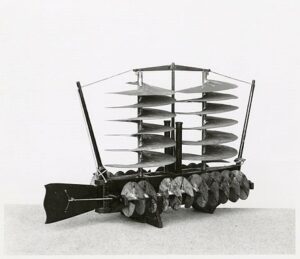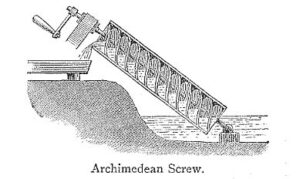The Confederate Helicopter – A Crazy Idea?
It Looked Good on Paper
General Winfield Scott’s Anaconda Plan of blockading Southern ports was successful by 1862. The Confederacy was having difficulty exporting cotton and importing weapons, putting a strain on its war effort. In Mobile, Alabama an ingenious architectural engineer named William C. Powers had a somewhat crazy idea that might stop the Union ships from blockading Mobile Bay and elsewhere.

Three-quarter view of William C. Powers’ model. National Air and Space Museum (NASM A-34342-A), Smithsonian Institution. https://airandspace.si.edu/stories/editorial/plans-little-known-confederate-helicopter
Powers helicopter design had an engine in the middle, two smokestacks, and two vertical Archimedes’ screws meant to provide lift and get the craft airborne. Another two horizontal Archimedes’ screws, one on each side, would provide the thrust needed to propel the helicopter forward. A rudder for steering and control was at the back of the craft. Two models were made of the helicopter, a small model and a full-sized one.
Powers deserves credit for his helicopter design ingenuity. His helicopter had some advanced technology built into it. For example, it had a lattice construction to provide strength while decreasing overall weight. The lattice construction was innovative and a sound idea. During WWII, the British used lattice construction when they built the Wellington bomber. Powers was cleverly ahead of his time.
Powers’ Confederate helicopter might have looked good on paper and in models, but it was never built. Providing money and resources for the helicopter was a problem for the Confederacy. The contraption also had serious design flaws. An expert at the Aeronautics Department of the National Air and Space Museum in Washington has examined Powers’ helicopter design. He has concluded that the steam engine was a major flaw.
Aeronautical expert Tom Poane of the museum claims that Civil War-times steam engines were impossible to construct light enough, small enough, and powerful enough, for Powers’ helicopter to fly. He also explains that the Archimedes’ screws would not provide enough lift and thrust needed for flight.
Archimedes’ screws were used in Egypt before the third century BC to move water from a low place up to higher irrigation ditches. They worked well in that capacity, but Archimedes’ screws were not meant to move air. The Archimedes’ screws would probably have been too heavy for a Civil War steam engine’s relatively limited power. Plus, the helicopter would have to carry a heavy bomb or bombs. These bombs would have to be large enough to destroy a ship.
Perhaps Powers’ Confederate helicopter sounds crazy to us today, but the Civil War brought on many inventions and innovations which sounded crazy for the times. These inventions included the telegraph, photography, submarines, ambulances, ironclads, and hot air balloons. All of these successful inventions changed how the Civil War was fought and life after the Civil War.
We know the Confederate helicopter was a failure. It was a dream that never got off the ground. What if Powers’ crazy helicopter idea had actually worked? How would it have influenced the Civil War? We can only imagine and speculate.
Maybe those Yankee blockading ships in Mobile Bay and in other Southern ports would have been bombed to smithereens by a fleet of Confederate helicopters. Then the Confederacy could have shipped cotton out and weapons in. That would be a Civil War game-changer as the Confederacy became stronger. Perhaps the outcome of the Civil War would’ve been different.
Before we judge Powers as being as mad as a March hare, let’s consider two brothers from Ohio who later had a crazy idea about creating a flying machine. Their airplane invention and dreams came true at Kitty Hawk, North Carolina on December 17, 1903, when their plane flew for fifty-nine seconds. Some people thought Wilbur and Orville Wright were crazy.
Even Wilbur Wright had doubts about man ever flying in a heavier-than-air machine:
“I confess that in 1901 I said to my brother Orville that man would not fly for fifty years. Two years later we ourselves made flights. This demonstration of my impotence as a prophet gave me such a shock that ever since I have distrusted myself and avoided all predictions.” …Wilbur Wright, 1908.

